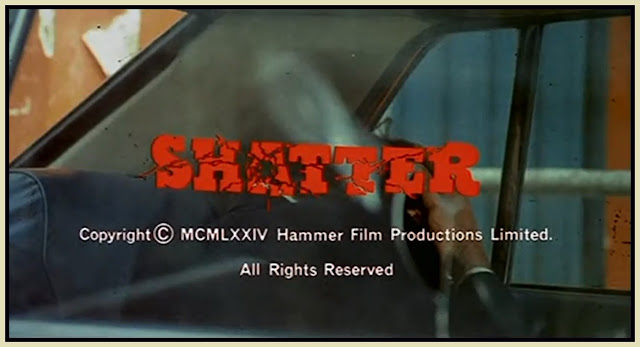SPOILER ALERT!
Chuck (Brian Cox) is released from prison and
goes to work for Martin Bluek (Peter Cushing), a mysterious gentleman
who has shown the ex-con some kindness. Unfortunately for Chuck, Martin may not be quite the charming old man he appears to be…
Following the dismal box office performance
of Legend of the 7 Golden Vampires, Shatter, To the Devil a Daughter
and, most disastrously, a big budget (and quite ill conceived) remake of
The Lady Vanishes, Hammer Films was pretty much dead in the water. Michael
Carreras sold off his interests in the company, retiring to many years
of wondering what might have been, while Brian Lawrence and Roy Skeggs
tried desperately to make a go of it in television. The two producers hatched an idea for a series of one hour telefilms, to be sold under the banner, The Hammer House of Horror.
PROLOGUE AND TITLE
SEQUENCE : THE SILENT SCREAM
It
seemed an ideal solution to bring the company up to date in the
changing climate of the 1980s – on the one hand, these films could be
cheaply
produced, and on the other, they could trade upon the studio’s
reputation by employing as many of their old guard actors and craftsmen
as possible. In terms of star power, their most
significant acquisition was Peter Cushing, who was hired to play the
lead in The Silent Scream. Given that
Christopher Lee was pursuing bigger fish in Hollywood at the time, the
likelihood of securing their biggest star was slim to nill, and indeed
he would not be lured back into the fold until 2010, when he agreed to
do a cameo in the “new” Hammer’s psychological thriller, The Resident. However,
securing Cushing’s services was a major plus, just the same, and the
actor responded with typical attention to detail and professionalism,
ensuring that Martin Bluek would be one of his most memorable roles for
the company.

The script by Francis Essex is taut and twist
laden, while director Alan Gibson (who had previously guided Cushing
through the two “mod” Dracula films, Dracula AD 1972 and The Satanic
Rites of Dracula) handles the material with skill and economy. The film is also graced by an exceptional, if small, cast. Cushing, as previously noted, is at his best here, running the gamut from charming to chilling. Bluek
presents himself as a kindly philanthropist, but the reality is that he
was once a concentration camp supervisor – and his interests in Chuck
are anything but philanthropic. The way in which he ingratiates himself to Chuck, only to set the desperate man up to fail, makes for quite an interesting
psychological game of cat and mouse.

Brian Cox, a few
years way from achieving major cult stardom by being the first actor to
portray Dr. Hannibal Lector on screen (in Michael Mann’s Manhunter,
1986), is typically intense and credible as the frustrated ex-con who is
trying to make a go of living life on the up and up. Cox
is tremendously sympathetic in the role, ensuring that the audience will
remain on his side through the story’s various twists and turns. Elaine Donnelly is also very effective as Chuck’s doting wife. Cox
and Donnelly have real chemistry together, and the scene wherein
Donnelly attempts to interest her husband sexually only to be shot down
because of the psychological trauma he has endured while in prison has a
truthful ring to
it.


Silent Scream would emerge as probably the
best of the thirteen episodes commissioned by ITC, though several other
episodes also warrant special mention, including Witching Time with Jon
Finch, Rude Awakening with Denholm Elliott, and Mark of Satan with Peter
McEnery. Sadly, despite the presence of such strong
acting talent, and the input of such talented Hammer personnel as
directors Peter Sasdy and Don Sharp (subbing for Terence Fisher, who
passed away before shooting began on the occult segment Guardian of the
Abyss) and screenwriter Anthony Hinds, the series didn’t generate a lot
of interest – and it would not be picked up for a second season.

Undaunted,
Lawrence and Skeggs responded with The Hammer House of Mystery and
Suspense, inflating the running time to 90 minutes, and switching the
emphasis from horror to suspense. It, too, failed to generate interest. Hammer
would then lie dormant for over twenty years, but like one of their
beloved vampires, they, too, would rise from the grave in the new
millennium.
Feature: Troy Howarth
Images: Marcus Brooks
































































